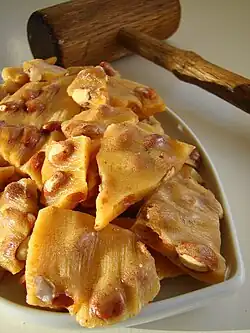Brittle (food)
Brittle is a type of confection consisting of flat broken pieces of hard sugar candy embedded with nuts such as pecans, almonds, or peanuts,[1] and which are usually less than 1 cm thick.
 Golden peanut brittle cracked on a serving dish | |
| Type | Confectionery |
|---|---|
| Main ingredients | Sugar, nuts, water, butter |
Types
It has many variations around the world, such as pasteli in Greece; sohan in Iran;[2] croquant in France;[3] alegría or palanqueta in Mexico;[4] panocha mani, panutsa mani, or samani in the Philippines (which can also be made with pili nut);[5] gozinaki in Georgia; gachak in Indian Punjab, chikki in other parts of India; kotkoti in Bangladesh;[6] sohan halwa in Pakistan; huasheng tang (花生糖) in China; thua tat (ถั่วตัด) in Thailand; and kẹo lạc, kẹo hạt điều in Vietnam. In parts of the Middle East, brittle is made with pistachios,[7] while many Asian countries use sesame seeds and peanuts.[8] Peanut brittle is the most popular brittle recipe in the United States.[9] The term "brittle" in the context of the food first appeared in print in 1892, though the candy itself has been around for much longer.[10]
Preparation
Traditionally, a mixture of sugar and water is heated to the hard crack stage corresponding to a temperature of approximately 295 °F (146 °C) to 309 °F (154 °C), although some recipes also call for ingredients such as glucose and salt in the first step.[11] Nuts are mixed with the caramelized sugar. At this point spices, leavening agents, and often peanut butter or butter are added. The hot candy is poured out onto a flat surface for cooling, traditionally a granite, a marble slab or a baking sheet. The hot candy may be troweled to uniform thickness. When the brittle is cool enough to handle, it is broken into pieces.[12] It is also rare to break the brittle into equal pieces.
Nougatine
Nougatine is a similar confection to brittle, but made of sliced almonds instead of whole peanuts, which are embedded in clear caramel.[13]
See also
References
- Kate Hopkins (2012). Sweet Tooth: The Bittersweet History of Candy. Macmillan. p. 34. ISBN 9781250011190. Retrieved April 11, 2013.
- Dinah Corley (2011). Gourmet Gifts: 100 Delicious Recipes for Every Occasion to Make Yourself & Wrap with Style. Houghton Mifflin Harcourt. p. 251. ISBN 978-1558324350.
- Lisa Abend (2011). The Sorcerer's Apprentices: A Season in the Kitchen at Ferran Adrià's elBulli. Simon and Schuster. p. 82.
- "El origen de la palabra Palanqueta y La Fiesta del Maíz". December 21, 2015.
- Polistico, Edgie (2017). Philippine Food, Cooking, & Dining Dictionary. Anvil Publishing, Inc. ISBN 9786214200870.
- "Peanut or Cheena Badam is popular outdoor leisure snack food in Bangladesh". January 11, 2011.
- Joel Denker (2007). The World on a Plate: A Tour Through the History of America's Ethnic Cuisine. University of Nebraska Press. p. 33. ISBN 978-0803260146. Retrieved April 11, 2013.
brittle pistachios middle east.
- Leela Punyaratabandhu (April 12, 2011). "Goddesses and peanut brittle: This year, celebrate Songkran in supernatural style". CNN. Retrieved April 11, 2013.
- Chu, Anita. Field Guide to Candy: How to Identify and Make Virtually Every Candy Imaginable. Philadelphia: Quirk, 2009.
- Olver, Lynne. "Brittle". The Food Timeline.
- "Peanut Brittle Recipe *Video Recipe*". Joyofbaking.com.
- Paula Deen (2011). Paula Deen's Southern Cooking Bible: The New Classic Guide to Delicious Dishes with More Than 300 Recipes. Simon & Schuster. p. 418. ISBN 9781416564126. Retrieved April 11, 2013.
- Gisslen, Wayne (2017). Professional baking (Seventh ed.). Hoboken, New Jersey: John Wiley & Sons. p. 656. ISBN 978-1-119-14844-9. OCLC 944179855.